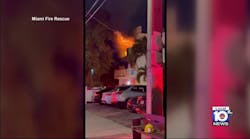Every community, large or small, has the likelihood of an overwhelming emergency event and often these incidents can transcend political jurisdictional boundaries. Responding to major events and reliance on outside assistance is rising. Personnel safety and operational efficiency is the priority while getting the proper help in a timely manner can be a complex challenge.
In reality, calling for an extra alarm or mutual aid is the only option in many escalating situations. As the duties of responders have expanded from the single dimension of fighting fires to presently handling alarm activations, medical calls, chemical spills, transportation accidents, industrial explosions, civil disorder and terrorist threats, the skills and tools required to control a crisis have taken a predictable and sometimes expensive twist.
Pre-incident preparation is often defined as any action taken in anticipation of the demands and needs of an emergency scene. The ability of an agency to assess the availability and capability of the required resources is critical to community preparedness. Life-saving strategies often hinge on a rapid response. Mass care, decontamination and sheltering always take cooperative planning.
The conventional step of gathering pertinent facts is useful in creating an immediate Incident Action Plan (IAP), but often more information is needed beyond the initial operational period. In recent years, the response and recovery from hurricanes, tornados and floods has caused many fire service leaders to seek a new direction. Legal liability, proof of qualifications and suitable financial reimbursement issues are significant roadblocks to creating a prearranged assistance agreement. Communication and coordination are essential to quickly obtaining properly trained and equipped personnel. A pre-defined process with standard procedures for ordering and obtaining resources is a valuable tool.
One worthwhile and straightforward, but relatively unknown source of tangible mutual aid can be the Emergency Management Assistance Compact (EMAC). This is a strong interstate partnership that provides assistance in an operational or logistical capacity during an officially acknowledged emergency. The activation is solely based on the governor of an affected state making the decision to declare a state of emergency. At this time, 49 states (the exception is Hawaii), the District of Columbia, Puerto Rico and the U.S. Virgin Islands are part of this voluntary pact.
The National Emergency Management Association (NEMA) consistently administrates EMAC activities. A standardized website is used to provide reliable information on request for assistance, mobilization steps and deployment locations. EMAC’s effectiveness is “deeply rooted†in a system approach for local and state authorities. It provides the framework for a National Response Plan (NRP). There are 13 articles that member states have agreed upon prior to acceptance. This format can resolve many of the common problems before in the pre-incident phase. Having a knowledgeable emergency management director empowered to compensate assisting states is vital. Understanding that automatic or self-deployment of personnel or materials will not be tolerated.
Pre-incident preparation greatly improves any fire department’s operations and customer service. Plans must include matching responsibilities and assignments to the potential of specific situations. Comprehensive procedures will ensure that the delivery of traditional services is not uninterrupted while embracing some non-traditional duties. Delivering medicine, packaged foods, bottled water and vaccines is necessary to the welfare of the community. Providing documentation on the assessment of property and infrastructure damage is fundamental to recovery. Sharing expertise, producing diagrams, loaning equipment and giving out supplies are all within the scope of contemporary disaster planning.
Pre-incident preparations will reduce frustration and greatly increase productivity when the overall safety of responders and citizens are in jeopardy. A major advantage of EMAC is the straightforward approach to mitigation. In today’s world of economic impact, it is important that fire service leaders are aware of all viable alternatives. EMAC can produce the type of help needed, under the most adverse conditions, to satisfactorily fulfill the public-safety mission. Using mutual aid during a prolonged crisis or on-going consequence phase demonstrates good judgment. There are many common-sense lessons from Hurricanes Katrina and Rita. Make sure that you have a plan to promptly initiate intrastate and interstate support.
In the simplest of terms, EMAC works because standard procedures have removed all the guesswork. All catastrophic incidents start at the local level and have a cascading effect. By keeping an accurate list of designated contacts in your firehouse, dispatch center or emergency operation center (EOC), your department can make a smooth transition from response to recovery to rebuilding.
Mistakes can be costly and front-line responders have only one opportunity to make a positive difference. In the aftermath of any type of incident, there is a fine line between community criticism and public praise. A lesson identified is not a lesson learned until effectively addressed.
William Shouldis is a deputy chief with more than 33 years of service with the Philadelphia Fire Department. He is currently assigned to the downtown high-rise district. Previously, Shouldis was the director of training and department’s safety officer. He is an adjunct instructor at the National Fire Academy in Emmitsburg, MD, and has a master’s degree in public safety.





